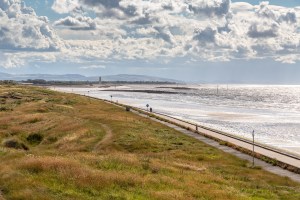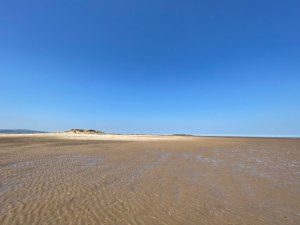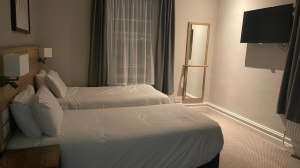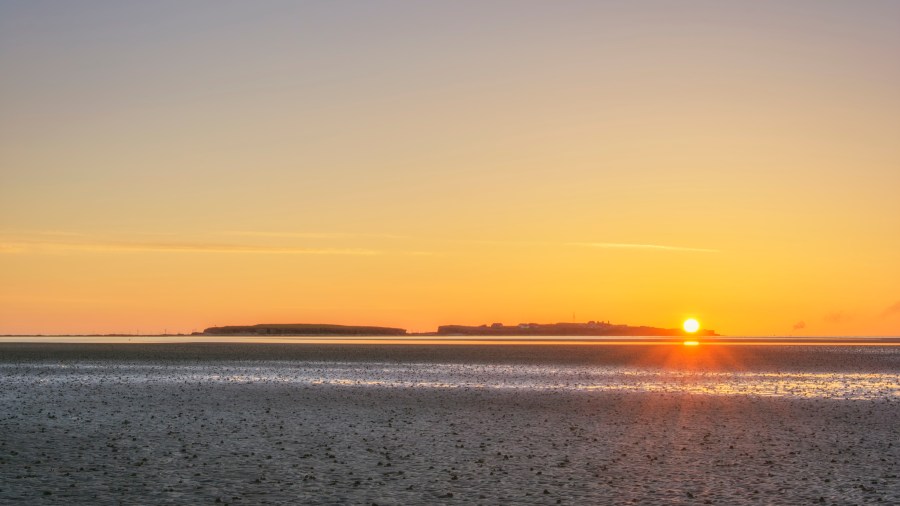Lee Ruddin makes a poignant return to The Wirral, the area grew up in, and discovers that much has changed since his childhood.
After disembarking the ferry across from Liverpool and exiting the terminal - a refurbished Grade II-listed building – we turn right onto Seacombe Promenade. Before starting our two-day, 12-mile walk to West Kirby via New Brighton, two miles away, we look back over our shoulders across the River Mersey – beyond the landing stage – towards the former UNESCO-recognised waterfront and the Three Graces: the Liver, Cunard and Port of Liverpool buildings.
One of the world’s best skylines, this view rarely disappoints, though this proud Wirralian is more focused on highlighting to his Mexican wife what Scousers mockingly call ‘The Dark Side’. With selfie stick tucked away, we soon approach Wallasey’s imperious Town Hall, whereupon our eyes are drawn to folk patiently lingering at fishing pitches.
Despite a 2023 survey celebrating the ‘species diversity’ of the once-declared ‘biologically dead’ River Mersey, it’s still surprising to see anglers – especially against the backdrop of a procession of container ships, oil tankers and the Isle of Man ferry. One of the anglers is Kiera Tuck, who enthuses over community-interest company Wirral Sea Angling Academy, principally because ‘therapeutic fishing’ helps her escape the demands of motherhood.
Much has disappeared from Wallasey’s coastline, most notably New Brighton Tower and Ballroom and Egremont Pier, but also Mother Redcap’s. Named after the colour of its landlady’s headwear, legend has it that the 18th-century tavern was at the centre of a tunnel network of smuggled contraband brought ashore by seafarers.
The eponymous care home occupies the site today, meaning we must stroll a little further – past the colourful Georgian villas of Marine Terrace – to take refreshments at The Magazine pub, part of the charming Magazines Conservation Area located just off the prom.
With whistles whetted and bellies full, we turn onto Magazine Brow to see the remnants of the battery and a gunpowder shack next to the Roundhouse facing Vale Park: landmarks, according to a local newspaper feature, which provided literary inspiration for the author of Treasure Island.

With Vale Park’s bandstand behind us, we turn back onto the prom and walk half a mile until New Brighton’s best-known landmark comes into view: Fort Perch Rock. Much has changed behind the sandstone walls of this 19th-century, Grade II defence battery since I last visited in 2009, with long-time custodian and history buff Doug Darroch latching onto the tastes of millennials by serving up caramel-flavoured speciality coffees (tasty) and running an escape room (testing).
The Victoria Quarter of The Wirral is another example of how this historic seaside resort has reinvented itself to become the toast of this part of the coast. Located on the backstreets behind the obligatory theatre (Floral Pavilion), fun fair (Adventureland) and chippy (Perch Fish Bar), the brainchild of local entrepreneur Dan Davies is less than ten minutes’ walk away from ‘The Fort’.
The repurposing of old shop units into quirky bars offering on-street dining and commissioning of eclectic street art spanning international (Martin Luther King) and local (Guide Dogs) themes provides an independent alternative to the mainstream chains at Marine Point. Collectively, they reversed the declining footfall, helping New Brighton rise from the post-package-holiday ashes to once again become a destination for day-trippers and weekend staycationers.
Leaving the gently crumbling Victorian cast-iron shelters behind us, we’re escorted along the prom – purportedly the longest in Britain, at just over two miles, and contender for the dullest were it not for the army (600+) of colourful remembrance benches affixed to the brutalist seawall – by shrieking gulls heading towards Wallasey Beach.
Despite the peninsula no longer being home to a Blue Flag beach, it has several Green Flag sites, the largest being North Wirral Coastal Park. The first two-odd miles of the four-mile linear park are more impressive given they encompass a sweeping golden beach, wartime ruins, the unmarked site at the rear of Leasowe Castle Hotel -where Merseyside’s only Roman skeleton was found in 1864 – and Leasowe Lighthouse, the oldest brick-built one in the country (1763), around which Janet Belton – chairperson of the charity tasked with its conservation – gives us a guided tour.

Back on terra firma, we saunter the remaining mile-and-a-half to Meols. Given its languorous present it’s hard to believe that this was once a prominent port, yet the antediluvian bounty discovered during the past two centuries (courtesy of coastal erosion) is proof enough, although the potential jewel of Meols’ crown remains to be confirmed: a Scandinavian clinker vessel.
Scientist Steve Harding, a Viking expert who is conducting DNA analysis of the wood fibre extracted, led February’s investigation at the Railway Inn pub, located half a mile inland, but since the patio area has been left as it was found we continue heading south west, past beached boats and an offshore wind farm, to observe oystercatchers probing the mudflats exposed at low tide.
Unlike Meols (and Wallasey), Hoylake doesn’t feature in Millets’ top ten ‘best coastal locations’ in England and Wales, and it’s perhaps easy to see why it’s more popular with wading birds than people: for some, like Hoylake Beach Community, it’s more beech than beach after suspending chemical and mechanical treatment (in 2019), an act that prompted a petition to redress the alleged human-environmental imbalance.
For others, such as Mark Howard of Hoylake Village Life, the reclamation versus rewilding binary is a distraction from coastal processes (sand accretion, saltmarsh development, dune succession) which suggest Birkdale – not Parkgate, a saltmarsh – is a comparator. All sides await Wirral Council’s new sustainable beach plan with baited breath.
Having covered ten miles yesterday, the hearty dinner and inviting bed at the Green Lodge Hotel were as welcome as the smile from Sarah, the landlady, who served our caffeine-fuelled, vegetarian brekkie. Sufficiently reenergised to walk the remaining six-odd miles, we turn right out of the main entrance and head down Stanley Road, which is comprised largely of imposing Victorian and Edwardian houses sandwiched between Royal Liverpool Golf Club and the sea.

From the slipway, it’s a mile-and-a-half to West Kirby via the Red Rocks Nature Reserve, where sand dunes safeguard the hallowed fairways and reedbeds help support Wirral’s only breeding colony of natterjack toads.
At the mouth of the River Dee lies Hilbre Island, a miniature archipelago which appears tantalisingly close as we stroll towards Dee Lane, the safest place to set off – tide-table permitting – across the boot- and paw-printed sands.
The four-mile round trip to the third island takes two hours and provides a first-rate vantage point to spot seals basking on the sandbanks. We leave exploring the eclectic buildings for another day, however, due to a stand-up-paddleboard taster session on the 52-acre Marine Lake. These sessions are great for beginners like us who wish to indulge their adventurous side, but only in the presence of a lake warden from Wirral Watersports Centre.
With the mercury rising and the beach filling up, we wander through West Kirby – a prosperous yet unpretentious village with an independent bookshop and boutiques satisfying discerning retail tastes – up to Grange Hill War Memorial. Although little more than 250ft in height, the views of the rolling Welsh hills are impressive enough that an entrepreneurial mind would consider charging.
Having stabbed around in takeaway trays with wooden forks the day previously, we walk back down to the White Lion for a bevy and a bite before catching the train to Liverpool, whereupon my wife reminds me how fortunate I was growing up in a place where coast, countryside and city are all in such close proximity.
FERRY ’CROSS THE MERSEY
Benedictine Monks started ferrying people between Wirral and Liverpool over 850 years ago, making it arguably the oldest regular river crossing service in the world.
Rich in history, there’s much to learn from the recorded commentary (provided by Gerry Marsden who immortalised the Mersey Ferry with his chart-topping, 1964 hit), not least how ferries played their part in the First World War. Those hard of hearing should position themselves close to a speaker.
The 50-minute, daily River Explorer Cruise departs hourly between 10am-6pm, with tickets costing £12/8 (adults/children). merseyferries.co.uk
WHERE TO STAY

We were hosted by The Green Lodge Hotel, part of the Marston’s Inns pub chain, and run by the ever-hospitable Sarah Bracey. Dating back to (at least) 1836, this stately home-looking venue on Stanley Road, Hoylake, offers six tastefully-decorated bedrooms (each with ensuite facilities) and a menu featuring pub classics and daily specials; vegan options extend to breakfast while kids are especially catered for. The range of alcoholic drinks served is as unsurprising as free parking, high-speed wi-fi and dog bowls surprisingly are. greenlodgehotelpub.co.uk
CHEERS TO THESE TWO PUBS…
Sensitively restored after a fire in 2010, the mid-18th-century Magazine Hotel was shortlisted for National Pub of the Year in 2022. Wash down the pie of the day with a pint of draught beer, either under its low beams or outside overlooking the river. the-magazine-hotel.co.uk)
Made famous in the 1970s for its ‘Ladies Only’ alcove, the White Lion Inn made headlines in 2021 after fully opening a kitchen for the first time in its 200-year-old history. Enjoy Thai food (Mon-Thurs) in the beer garden or an award-winning local cask ale in a cosy nook (from where you can participate in a quiz on Mondays and enjoy live music at weekends). whitelionwestkirby.co.uk






